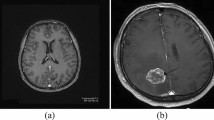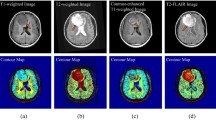Abstract
The focus of this paper is diagnosing and differentiating Astrocytomas in MRI scans by developing an interval Type-2 fuzzy automated tumor detection system. This system consists of three modules: working memory, knowledge base, and inference engine. An image processing method with three steps of preprocessing, segmentation and feature extraction, and approximate reasoning is used in inference engine module to enhance the quality of MRI scans, segment them into desired regions, extract the required features, and finally diagnose and differentiate Astrocytomas. However, brain tumors have different characteristics in different planes, so considering one plane of patient’s MRI scan may cause inaccurate results. Therefore, in the developed system, several consecutive planes are processed. The performance of this system is evaluated using 95 MRI scans and the results show good improvement in diagnosing and differentiating Astrocytomas.










Similar content being viewed by others
References
Turkington, C., The encyclopedia of the brain and brain disorders. Facts On File, Inc., New York, 2002.
Ali-osman, F. (Ed.), Brain tumors. Humana Press Inc., Totowa, 2005.
Baert, A. L., and Sartor, K., MR imaging in white matter diseases of the brain and spinal cord. Springer-Verlag, Berlin, 2005.
Brandt, T., Dichgans, J. eds: Neurological disorders: course and treatment. Academic Press (2003).
Kwon, K.-C., Lim, Y.-T., Kim, C.-H., Kim, N., Park, C., Yoo, K.-H., Son, S.-H., and Jeon, S.-I., Microwave tomography analysis system for breast tumor detection. J. Med. Syst. 36:1757–1767, 2012.
Boquete, L., Ortega, S., Miguel-Jiménez, J. M., Rodríguez-Ascariz, J. M., and Blanco, R., Automated detection of breast cancer in thermal infrared images, based on independent component analysis. J. Med. Syst. 36:103–111, 2012.
Francis, S. V., Sasikala, M., and Saranya, S., Detection of breast abnormality from thermograms using curvelet transform based feature extraction. J. Med. Syst. 38:1–9, 2014.
Fazel Zarandi, M. H., Zarinbal, M., and Izadi, M., Systematic image processing for diagnosing brain tumors: a type-II fuzzy expert system approach. Appl. Soft Comput. 11:285–294, 2011.
Vadivel, A., and Surendiran, B., A fuzzy rule-based approach for characterization of mammogram masses into BI-RADS shape categories. Comput. Biol. Med. 43:259–267, 2013.
Harati, V., Khayati, R., and Farzan, A., Fully automated tumor segmentation based on improved fuzzy connectedness algorithm in brain MR images. Comput. Biol. Med. 41:483–492, 2011.
Miranda, G.H.B., Felipe, J.C.: Computer-aided diagnosis system based on fuzzy logic for breast cancer categorization. Comput. Biol. Med. (2014).
T. Moritani, S. Ekholm, P.-L.Westesson: Diffusion-weighted MR imaging of the brain. Springer-Verlag (2005).
Zarinbal, M., Fazel Zarandi, M.H.: Type-2 fuzzy image enhancement: Fuzzy rule based approach. J. Intell. Fuzzy Syst. (2014).
Zacharaki, E. I., Wang, S., Chawla, S., Soo Yoo, D., Wolf, R., Melhem, E. R., and Davatzikos, C., Classification of brain tumor type and grade using MRI texture and shape in a machine learning scheme. Magn. Reson. Med. 62:1609–18, 2009.
El-Dahshan, E.-S. a., Mohsen, H. M., Revett, K., and Salem, A.-B. M., Computer-aided diagnosis of human brain tumor through MRI: a survey and a new algorithm. Expert Syst. Appl. 41:5526–5545, 2014.
Meyer-base, A.: pattern recognition for medical imaging. Academic Press (2004).
Zarinbal, M., Fazel Zarandi, M. H., and Turksen, I., Relative entropy fuzzy c-means clustering. Inf. Sci. 260:74–97, 2014.
Mendel, J. M., and John, R. I. B., Type-2 fuzzy sets made simple. Fuzzy Syst. IEEE Trans. 10:117–127, 2002.
Melin, P., Mendoza, O., and Castillo, O., Face recognition with an improved interval type-2 fuzzy logic sugeno integral and modular neural networks. IEEE Trans. Syst. Man Cybern. Syst. Hum. 41:1001–1012, 2011.
Palanivelu, M., and Duraisamy, M., Color textured image segmentation using ICICM - interval type-2 fuzzy C-means clustering hybrid approach. Eng. J. 16:115–126, 2012.
Wang, W., Liu, X., and Qin, Y., Multi-attribute group decision making models under interval type-2 fuzzy environment. Knowl.-Based Syst. 30:121–128, 2012.
Martínez, G.E., Melin, P., Mendoza, O.D., Castillo, O.: Face recognition with choquet integral in modular neural networks. in: recent advances on hybrid approaches for designing intelligent systems. pp. 437–449. Springer (2014).
Barnett, G. H. (Ed.), High-grade gliomas: diagnosis and treatment. Humana Press, Totowa, 2007.
Henson, J. W., Gaviani, P., and Gonzalez, R. G., MRI in treatment of adult gliomas. Lancet Oncol. 6:167–175, 2005.
Bovik, A. ed: Handbook of image and video processing. Academic Press (2000).
Parker, J.R.: Algorithms for image processing and computer vision. Wiley Publishing, Inc. (2011).
Romeo, J., Pajares, G., Montalvo, M., Guerrero, J. M., Guijarro, M., and de la Cruz, J. M., A new expert system for greenness identification in agricultural images. Expert Syst. Appl. 40:2275–2286, 2013.
Ericeira, D. R., Silva, A. C., de Paiva, A. C., and Gattass, M., Detection of masses based on asymmetric regions of digital bilateral mammograms using spatial description with variogram and cross-variogram functions. Comput. Biol. Med. 43:987–999, 2013.
Wu, Q., Pang, X., and Han, Z., Fuzzy automata system with application to target recognition based on image processing. Comput. Math. Appl. 61:1267–1277, 2011.
Guerrero, J. M., Guijarro, M., Montalvo, M., Romeo, J., Emmi, L., Ribeiro, A., and Pajares, G., Automatic expert system based on images for accuracy crop row detection in maize fields. Expert Syst. Appl. 40:656–664, 2013.
Borges Sampaio, W., Moraes Diniz, E., Corrêa Silva, A., Cardoso De Paiva, A., and Gattass, M., Detection of masses in mammogram images using CNN, geostatistic functions and SVM. Comput. Biol. Med. 41:653–664, 2011.
Turksen, I.: An ontological and epistemological perspective of fuzzy set theory. Elsevier Science Inc. (2005).
Medasani, S., and Kim, J., An overview of membership function generation techniques for pattern recognition. Int. J. Approx. Reason. 19:391–417, 1998.
Oliveira, J. V. D., and Pedrycz, W., Advances in fuzzy clustering and its applications. Wiley, Chichester, 2007.
Melin, P., and Castillo, O., A review on the applications of type-2 fuzzy logic in classification and pattern recognition. Expert Syst. Appl. 40:5413–5423, 2013.
Melin, P., Gonzalez, C., Castro, J. R., Mendoza, O., and Castillo, O., Edge-detection method for image processing based on generalized type-2 fuzzy logic. Fuzzy Syst. IEEE Trans. 22:1515–1525, 2014.
Zarinbal, M., Zarandi, M. F., and Turksen, I., Interval type-2 relative entropy fuzzy C-means clustering. Inf. Sci. 272:49–72, 2014.
Linda, O., and Manic, M., General type-2 fuzzy C-means algorithm for uncertain fuzzy clustering. IEEE Trans. Fuzzy Syst. 20:883–897, 2012.
Pedrycz, W., Collaborative fuzzy clustering. Pattern Recogn. Lett. 23:1675–1686, 2002.
Falcon, R., Jeon, G., Bello, R., Jeong, J.: Learning collaboration links in a collaborative fuzzy clustering environment. In: MICAI: Advances in artificial intelligence lecture notes in computer science. pp. 483–495 (2007).
Yu, F., Tang, J., Cai, R.: A necessary preprocessing in horizontal collaborative fuzzy clustering. IEEE Int. Conf. Granular Comput. (GRC 2007). 399–399 (2007).
Coletta, L. F. S., Vendramin, L., Hruschka, E. R., Campello, R. J. G. B., and Pedrycz, W., Collaborative Fuzzy clustering algorithms: some refinements and design guidelines. IEEE Trans. Fuzzy Syst. 20:444–462, 2012.
Pedrycz, W., and Rai, P., Collaborative clustering with the use of fuzzy C-means and its quantification. Fuzzy Sets Syst. 159:2399–2427, 2008.
Pedrycz, W.: Knowledge-based clustering from data to information granules. John Wiley & Sons, Inc. (2005).
Zarinbal, M., Zarandi, M. H. F., and Turksen, I. B., Relative entropy collaborative fuzzy clustering method. Pattern Recogn. 48:933–940, 2015.
Hwang, C., and Rhee, F. C., Uncertain fuzzy clustering : Interval type-2 fuzzy approach to C -means. IEEE Trans. Fuzzy Syst. 15:107–120, 2007.
Nixon, M.S., Aguado, A.S.: Feature extraction and image processing. Newnes (2002).
Khotanlou, H., Colliot, O., Atif, J., and Bloch, I., 3D brain tumor segmentation in MRI using fuzzy classification, symmetry analysis and spatially constrained deformable models. Fuzzy Sets Syst. 160:1457–1473, 2009.
Zhang, A., Gertych, A., Liu, B.J.: Automatic bone age assessment for young children from newborn to 7-year-old using carpal bones. Comput. Med. Imag. Graph. 31, 299–310.
Kang, H., Pinti, A., Taleb-Ahmeda, A., and Zeng, X., An intelligent generalized system for tissue classification on MR images by integrating qualitative medical knowledge. Biomed. Signal Proc. Contrl. 6:21–26, 2011.
Shang, C., and Barnes, D., Fuzzy-rough feature selection aided support vector machines for Mars image classification. Comput. Vis. Image Underst. 17:202–213, 2013.
Duda, R.O., Hart, P.E., Stork, D.G.: Pattern classification. Wiley-Interscience (2000).
Bishop, C., Pattern recognition and machine learning. Springer Science, New York, 2006.
Author information
Authors and Affiliations
Corresponding author
Additional information
This article is part of the Topical Collection on Systems-Level Quality Improvement
Appendix
Appendix
As mentioned before, horizontal and vertical modes are two important modes of collaborative clustering methods. IT2RECFC method (Eq.(9)) can be rewritten as Eq.(19) for horizontal mode (HIT2RECFC) and Eq.(20) for vertical mode (VIT2RECFC):
where, γ H [ii] and γ V [ii] are nonnegative coefficients of collaboration for HIT2RECFC and VIT2RECFC, respectively.
Theorem 1-HIT2RECFC: U ik [ii] that optimizes Eq.(19) is obtained by:
or,
where, W 0(.) is the principle branch of Lambert-W function and
By considering d ik [ii] as Euclidean distance, the prototypes are updated by:
Proof:
Using Lagrangian multiplier, \( {\varLambda}_k=\left[{\underline{\lambda}}_k,{\overline{\lambda}}_k\right] \), the first constraint term in Eq.(19), \( \left({\displaystyle \sum_{i=1}^{c\left[ii\right]}{U}_{ik}}\left[ii\right]=\mathbf{1}\right) \), could be included in the objective function. Thus, minimization of the following function with respect to U[ii] is our concern:
Minimizing Eq.(26) with respect to U[ii] is equivalent to minimizing individual objective function with respect to each U ik [ii], as the membership values of each observation in each cluster are independent of the other observations. The three necessary conditions leading to the local minimum are \( \frac{\partial {J}_{HIT2 RECFC}\left[ii\right]}{\partial {U}_{ik}\left[ii\right]}=\mathbf{0},\kern0.5em \frac{\partial {J}_{HIT2 RECFC}\left[ii\right]}{\partial {\gamma}_H\left[ii\right]}=\mathbf{0},\kern0.5em \frac{\partial {J}_{HIT2 RECFC}\left[ii\right]}{\partial {\varLambda}_k}=\mathbf{0}\kern1em \forall i,k \).
The first necessary condition, \( \frac{\partial {J}_{HIT2 RECFC}\left[ii\right]}{\partial {U}_{ik}\left[ii\right]}=\mathbf{0} \), results in:
Thus, for ii th data site, U ik [ii] is obtained by:
The second necessary condition is \( \frac{\partial {J}_{HIT2 RECFC}\left[ii\right]}{\partial {\gamma}_H\left[ii\right]}=\mathbf{0} \), so:
For the third necessary condition, \( \frac{\partial {J}_{RECFC}\left[ii\right]}{\partial {\varLambda}_k}=\mathbf{0} \), solving \( {\displaystyle \sum_{i=1}^{c\left[ii\right]}{U}_{ik}}\left[ii\right]=\mathbf{1} \) with respect to Λ k would not result in an exact solution, so the bounds have to be found. This problem could be studied from two viewpoints, (1) U ik [ii] ≥ 0 ∀ i, k and (2) U ik [ii] ≤ 1 ∀ i, k. As
U ik [ii] ≥ 0 ∀ i, k is always true. Now consider U ik [ii] ≤ 1 ∀ i, k:
So, the bounds for \( {\varLambda}_k=\left[{\underline{\lambda}}_k,{\overline{\lambda}}_k\right] \) would be:
By differentiating Eq.(27) with respect to the prototypes, V i [ii] are obtained. Here, the d ik [ii] is considered Euclidean distance function, so the prototypes are updated by:
or,
where, \( {H}_i=\left(\frac{{\displaystyle \sum_{k=1}^N{\underline{u}}_{ik}^m\left[ii\right]{x}_k\left[ii\right]}}{{\displaystyle \sum_{k=1}^N{\underline{u}}_{ik}^m\left[ii\right]}},\frac{{\displaystyle \sum_{k=1}^N{\underline{u}}_{ik}^m\left[ii\right]{x}_k\left[ii\right]}}{{\displaystyle \sum_{k=1}^N{\overline{u}}_{ik}^m\left[ii\right]}},\frac{{\displaystyle \sum_{k=1}^N{\overline{u}}_{ik}^m\left[ii\right]{x}_k\left[ii\right]}}{{\displaystyle \sum_{k=1}^N{\underline{u}}_{ik}^m\left[ii\right]}},\frac{{\displaystyle \sum_{k=1}^N{\overline{u}}_{ik}^m\left[ii\right]{x}_k\left[ii\right]}}{{\displaystyle \sum_{k=1}^N{\overline{u}}_{ik}^m\left[ii\right]}}\right) \).
■End of proof.■
Theorem 2-VIT2RECFC: U ik [ii] that optimizes Eq.(20) is obtained by:
where,
By considering d ik [ii] as Euclidean distance, the prototypes are updated by:
Proof: This theorem can be proved in the same manner as Theorem 1. ■
Rights and permissions
About this article
Cite this article
Zarinbal, M., Fazel Zarandi, M.H., Turksen, I.B. et al. A Type-2 Fuzzy Image Processing Expert System for Diagnosing Brain Tumors. J Med Syst 39, 110 (2015). https://doi.org/10.1007/s10916-015-0311-6
Received:
Accepted:
Published:
DOI: https://doi.org/10.1007/s10916-015-0311-6




